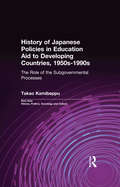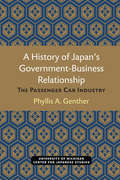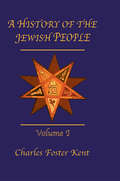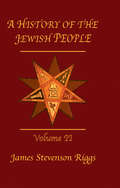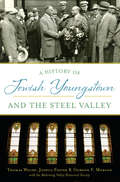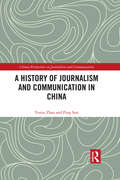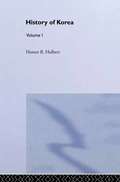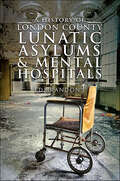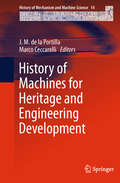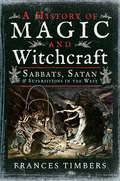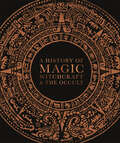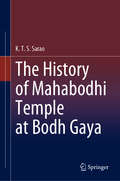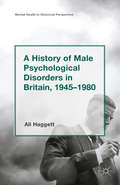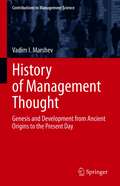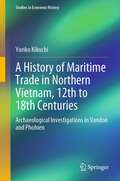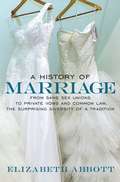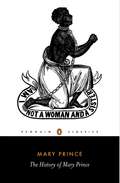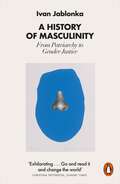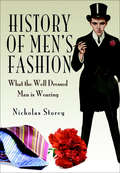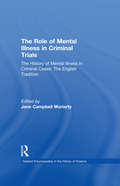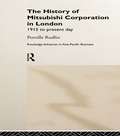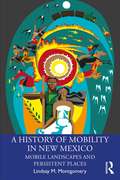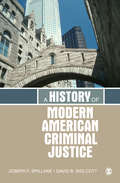- Table View
- List View
History of Japanese Policies in Education Aid to Developing Countries, 1950s-1990s: The Role of the Subgovernmental Processes (East Asia: History, Politics, Sociology and Culture)
by Takao KamibeppuFirst published in 2002. Routledge is an imprint of Taylor & Francis, an informa company.
A History of Japan’s Government-Business Relationship: The Passenger Car Industry (Michigan Papers in Japanese Studies #20)
by Phyllis A. GentherDespite the economic and political importance of the U.S.-Japan relationship and the extensive attention paid to automotive trade, few American scholars or policy makers are familiar with the history of Japanese government-business relations, either generally or for specific industries such as passenger cars. This book hopefully helps in a small way to fill that gap in our knowledge and, thus, to help strengthen the foundation from which we make public policy decisions about bilateral trade. [ix]
History Of The Jewish People Vol 1: During The Babylonian, Persian, And Greek Periods
by KentFirst published in 2007. Routledge is an imprint of Taylor & Francis, an informa company.
History Of The Jewish People Vol 2: During The Maccabean And Roman Periods (including New Testament Times)
by RiggsFirst published in 2007. Routledge is an imprint of Taylor & Francis, an informa company.
History of Jewish Youngstown and the Steel Valley, A (American Heritage)
by Thomas Welsh Gordon F. Morgan Joshua Foster The Mahoning Valley Historical SocietyFounded in the Mahoning Valley during 1837, a tiny settlement of secular German immigrants grew into one of the most influential centers of Jewish life in the Midwest. Home to nationally renowned rabbis and Zionist firebrands alike, the community produced an astonishing array of leaders in an impressive range of fields throughout the twentieth century. This notable legacy ranges from the entertainment juggernaut of Warner Brothers to the Arby’s fast-food empire and the prominent Youngstown Sheet & Tube, among many others. Authors Thomas Welsh, Joshua Foster and Gordon F. Morgan trace the unique history of one of Ohio’s oldest Jewish communities from its humble beginnings into the challenging climate of the new millennium.
A History of Journalism and Communication in China (Chinese Perspectives on Journalism and Communication)
by Yunze Zhao Ping SunFrom a modern perspective, journalism is highly relevant to modern society, along with the emergence of mass printing system and professionalisation. This book, however, expands the meaning of journalism and views it as a social process. It will not only explore the roots and development of Chinese journalism and communication, but also demonstrate how Chinese journalism and communication interact and struggle with social culture and politics. Arranged in chronological order mainly, this book examines the initial development of Chinese journalism in ancient times in chapter 1, which from then manifested strong political attributes. After the Opium War in 1840, missionaries and businessmen from the West started to set up newspapers and periodicals in China, which brought about the birth of China’s modern journalism industry. Then China’s private newspapers and political party’s press are studied, which are closely linked with political revolutions and have a far-reaching impact on modern Chinese society. What happened to Chinese journalism and communication after the founding of People’s Republic of China in 1949? This book reviews the newspaper reforms, and studies the great negative impacts brought by "Cultural Revolution". Noteworthy news phenomena after the reform and opening-up are also covered. This book will appeal to scholars and students in journalism, communication and Chinese studies. Readers interested in Chinese society and modern Chinese history will also be attracted by it.
A History of Judaism: From Its Origins to the Present
by Martin GoodmanA sweeping history of Judaism over more than three millenniaJudaism is one of the oldest religions in the world, and it has preserved its distinctive identity despite the extraordinarily diverse forms and beliefs it has embodied over the course of more than three millennia. A History of Judaism provides the first truly comprehensive look in one volume at how this great religion came to be, how it has evolved from one age to the next, and how its various strains, sects, and traditions have related to each other.In this magisterial and elegantly written book, Martin Goodman takes readers from Judaism's origins in the polytheistic world of the second and first millennia BCE to the temple cult at the time of Jesus. He tells the stories of the rabbis, mystics, and messiahs of the medieval and early modern periods and guides us through the many varieties of Judaism today. Goodman's compelling narrative spans the globe, from the Middle East, Europe, and America to North Africa, China, and India. He explains the institutions and ideas on which all forms of Judaism are based, and masterfully weaves together the different threads of doctrinal and philosophical debate that run throughout its history.A History of Judaism is a spellbinding chronicle of a vibrant and multifaceted religious tradition that has shaped the spiritual heritage of humankind like no other.
The History of Korea
by H. B. HulbertWith a modern introduction by Clarence Weems, originally published in Seoul in 1905 to wide acclaim as the only authentic history of Korea from prehistory to the Twentieth Century, this two volume work remains required reading for students of Western historiography of Korea.
History Of Korea
by Tennant"Go with me to a land whose life for ages has been a mystery", wrote a 19th-century visitor to Korea, "a land which from time unknown has kept aloof, whose people might have been the denizens of another planet". He may not have known that in the 4th century AD they had controlled much of north-east Asia and in the 8th their ships had dominated the trade of the Yellow Sea, nor did he guess the astonishing transformation that lay ahead of Korea in the 20th century - all of which are chronicled here. This is the first full-length general history of the country to be published in Britain, and incorporates in its early chapters Chinese and Korean material not previously published in any Western language. Beginning with the prehistoric era, the book provides a uniquely detailed treatment of the earlier periods in Korea's evolution. The work progresses through the era of the Three Kingdoms, Silla, Koguryo and Paekche; the Koryo period (918-1392 AD) which saw the war with the Khitan, the coming of the Mongols and the invasion of Japan; and the rule of the Yi dynasty from 1392 to 1910, which saw the flowering of Korean Confucianism, the invasion of Hideyoshi, the Manchu invasion, long periods of isolation and then the opening of the country to the West. Following this came the decades (1910-1945) when Korea was under Japanese rule; the period of the Sino-Japanese war, the Russo-Japanese war and Asian co-prosperity. Moving towards the present day, the work concludes with the story of the two Koreas and the drawing of the line between them, South Korea's economic successes and the adoption of a new constitution in 1987. Full and accurate records of all the significant persons and dates are provided, including events in China and Japan in so far as they involved Korea. Richly descriptive, with an emphasis on skilfull accounts of the major occurrences, battles and court scandals of the times, this lucidly written history makes absorbing reading, and should be welcomed by the general reader.
A History of London County Lunatic Asylums & Mental Hospitals
by Ed BrandonFrom the Middle-Ages onwards, London’s notorious Bedlam lunatic hospital saw the city’s ‘mad’ locked away in dank cells, neglected and abused and without any real cure and little comfort. The unprecedented growth of the metropolis after the Industrial Revolution saw a perceived ‘epidemic’ of madness take hold, with ‘county asylums’ seen by those in power as the most humane or cost-effective way to offer the mass confinement and treatment believed necessary. The county of Middlesex – to which London once belonged – would build and open three huge county asylums from 1831, and when London became its own county in 1889 it would adopt all three and go on to build or run another eight such immense institutions. Each operated much like a self-contained town; home to thousands and often incorporating its own railway, laundries, farms, gardens, kitchens, ballroom, sports pitches, surgeries, wards, cells, chapel, mortuary, and more, in order to ensure the patients never needed to leave the asylum’s grounds. Between them, at their peak London’s eleven county asylums were home to around 25,000 patients and thousands more staff, and dominated the physical landscape as well as the public imagination from the 1830s right up to the 1990s. Several gained a legacy which lasted even beyond their closure, as their hulking, abandoned forms sat in overgrown sites around London, refusing to be forgotten and continuing to attract the attention of those with both curious and nefarious motives. Hanwell (St Bernard’s), Colney Hatch (Friern), Banstead, Cane Hill, Claybury, Bexley, Manor, Horton, St Ebba’s, Long Grove, and West Park went from being known as ‘county lunatic asylums’ to ‘mental hospitals’ and beyond. Reflecting on both the positive and negative aspects of their long and storied histories from their planning and construction to the treatments and regimes adopted at each, the lives of patients and staff through to their use during wartime, and the modernisation and changes of the 20th century, this book documents their stories from their opening up to their eventual closure, abandonment, redevelopment, or destruction.
History of Machines for Heritage and Engineering Development
by J. M. Portilla Marco CeccarelliThis volume contains a selection of papers whose content have been presented at the International conferences CIPHI on Cultural Heritage and History of Engineering at University of Las Palmas de Gran Canaria in the Canary Islands, Spain, in recent years. The conference series is aimed at bringing together researchers, scholars and students from a broad range of disciplines referring to the History of Engineering and Cultural Heritage, in a unique multidisciplinary forum to stimulate collaboration among historians, architects, restaurateurs, and engineers. These papers illustrate, by treating specific emblematic topics and problems, technical developments in the historical evolution of engineering concerning cultural heritage. Thus, emphasis is given to a discussion of matters of cultural heritage with engineering history by reporting authors' experiences and views. Topics treated include: reutilization of industrial heritage: the unique example of the Royal Segovia Mint in Spain; the image of factories; Pedro Juan De Lastanosa and "the twenty-one books of devices and machines of Juanelo"; the historical development of paper-mills and their machines in South Latium during 19th century; a virtual reconstruction of a wave-powered flour mill from 1801; 3D modelling and animation study of the industrial heritage wonders; a new model of the hydraulic machine known as "el artificio de Juanelo"; and the mystery of one Havana portrait, on the first steam machine in Cuba. This work has been made possible thanks to the invited authors who have enthusiastically shared this initiative and who have spent time and effort in preparing the papers in much more detail that in the conference presentations.
A History of Magic and Witchcraft: Sabbats, Satan & Superstitions in the West
by Frances TimbersThe author of Magic and Masculinity explores the history and development of magic and witchcraft in Western society. Broomsticks, cauldrons, familiars, and spells—magic and witchcraft conjure a vivid picture in our modern-day imagination. While much of our understanding is rooted in superstition and myth, the history of magic and witchcraft offers a window into the past. It illuminates the lives of ordinary people in the past and elucidates the fascinating pop culture of the premodern world. Blowing away folkloric cobwebs, this enlightening new history dispels many misconceptions surrounding witchcraft and magic that we still hold today. From Ancient Greece and Rome to the Middle Ages and the Early Modern Era, historian Frances Timbers details the impact of Christianity and popular culture in the construction of the figure of the &“witch.&” The development of demonology and ceremonial magic is combined with the West&’s troubled past with magic and witchcraft to chart the birth of modern Wiccan and Neopagan movements in England and North America. Witchcraft is a metaphor for oppression in an age in which persecution is an everyday occurrence somewhere in the world. Fanaticism, intolerance, prejudice, authoritarianism, and religious and political ideologies are never attractive. Beware the witch hunter!
A History of Magic, Witchcraft, and the Occult (DK A History of)
by DKDiscover the beguiling history of witchcraft, magic, and superstition through the centuries in this stunningly illustrated title. A History of Magic, Witchcraft and the Occult charts the extraordinary narrative of one of the most interesting and often controversial subjects in the world, covering everything from ancient animal worship and shamanism, through alchemy and divination to modern Wicca and the resurgence of the occult in 21st-century literature, cinema, and television. Providing readers with a comprehensive account of everything from Japanese folklore and Indian witchcraft to the differences between black and white magic, and dispelling myths such as those surrounding the voodoo doll and Ouija, the book explores the common human fascination with spells, superstition, and the supernatural. This riveting read on witchcraft further includes: - Engaging text and lavish illustrations with over 500 full-color images that bring the subject to life.- Special features on aspects of magic, such as oracle bones of ancient China, the Knights Templar, and magic at the movies, and &“plants and potions&”, such as mandrake and belladonna examine topics in great detail.- Quick-fact panels explore magic origins, key figures, key deities, uses in spells, structures of religions, and more.The perfect introduction to magic and the occult, it explores forms of divination from astrology and palmistry to the Tarot and runestones and offers key insights into the ways in which magic has interacted with religion. The most comprehensive illustrated history of witchcraft available, A History of Magic, Witchcraft and the Occult will enthral and fascinate anyone interested in spiritualism and the occult.
The History of Mahabodhi Temple at Bodh Gaya
by K.T.S. SaraoThis book offers an overview of the emergence of Bodh Gayā as a sacred site within Gayā Dharmakṣetra. It contextualizes the different encounters, incidents, and legends connected to the Buddha’s experiences shortly before and after he attained Bodhi – when, spiritually speaking, he was extremely lonely and was trying to carve a place for himself in the highly competitive Gayā Dharmakṣetra. Further, the book examines the role of various personalities and institutions contributed towards the emergence of Mahābodhi Temple. It incorporates a wealth of research on the role of the Victorian Indologists as well as the colonial administrators, the Giri mahants, and Anagārika Dharmapāla, to understand the material milieu pertaining not only to its identity but also access to spiritual resources as its conservation and development. This book is an indispensable read for students and scholars of history, cultural studies, and art and architecture as well as practitioners of Buddhism and Hinduism.
A History of Male Psychological Disorders in Britain, 1945-1980 (Mental Health in Historical Perspective)
by Alison HaggettThis book is open access under a CC BY license and explores the under-researched history of male mental illness from the mid-twentieth century. It argues that statistics suggesting women have been more vulnerable to depression and anxiety are misleading since they underplay a host of alternative presentations of 'distress' more common in men.
History of Management Thought: Genesis and Development from Ancient Origins to the Present Day (Contributions to Management Science)
by Vadim I. MarshevThis book describes the millennia-long process of the genesis, formation, struggle, and change of views on the management of social organizations in various countries around the world; in other words, it characterizes the worldwide evolution of the History of Management Thought (HMT) - ideas, concepts, theories, paradigms, and scientific schools - from Antiquity to the present. The book is the outcome of extensive research, based on the analysis, generalization, and systematization of foreign and domestic published literature, as well as on the gathering and analysis of unique archival materials. For the first time in the historical and managerial literature, the book puts forward original definitions of three historical and managerial sciences - the History of Management, the History of Management Thought, and the Historiography of Historical and Managerial Research. It addresses the main challenges in pursuing Historical and Scientific Research (HSR), the main “subject” levels of HSR and specific methodological problems concerning HMT, as well as epistemological methods for identifying key factors in and causes of the advent and evolution of HMT. This book presents both the origins of management thought dating back to the 5th millennium BC and the latest management concepts of the early 21st century. In particular, it traces the origins and sources of management thought, reflected in the works of thinkers and statesmen of the Ancient World (Egypt, Western Asia, China, India, Greece, and Rome), the era of feudalism, and the Middle Ages (Byzantium, Western Europe, and England), the era of inception capitalism (Western Europe and the USA), as well as the new and recent history of management thought of the 20th and 21st centuries. In addition, for the first time in History of Management literature, it presents the history of Russian management thought from the 9th century to modern concepts and scientific schools.
A History of Maritime Trade in Northern Vietnam, 12th to 18th Centuries: Archaeological Investigations in Vandon and Phohien (Studies in Economic History)
by Yuriko KikuchiThis book analyzes the role of Đại Việt (Vietnam) in the maritime Asian trading network of the thirteenth through the eighteenth centuries as it systematically integrates the results of archaeological investigations. The first half of the book consolidates reports from excavations conducted at Vân Đồn and Phố Hiến, trading ports of Đại Việt, incorporating sophisticated archaeological techniques distinctive of Japan in the presentations of the data. These are accompanied by precise scale drawings, detailed classifications, and quantitative analyses of unearthed artifacts. The latter half of the book discusses the materials discovered in archaeological investigations, specifically ceramics and coins, in terms of the relations among sites and networks of production, distribution, and consumption, from a broader Asian geohistorical perspective. To this end, the diplomatic policies and trading activities of each era in Vietnam are discussed, integrating the results of archaeological investigations with studies of historical documents. Expanding beyond Vietnam, results of the archaeological investigations in other maritime Asian countries, such as Japan, Indonesia, Laos, and the Philippines, are introduced, to inform a comparative study that combines all such data from both archaeology and history in a single volume as materials for broader discussion. This book is expected to contribute to international academic discourse on the history of maritime Asia and help open a new phase of scholarly endeavor in this field.
A History of Marriage: From Same Sex Unions to Private Vows and Common Law, the Surprising Diversity of a Tradition
by Elizabeth AbbottWhat does the "tradition of marriage" really look like? In A History of Marriage, Elizabeth Abbott paints an often surprising picture of this most public, yet most intimate, institution. Ritual of romance, or social obligation? Eternal bliss, or cult of domesticity? Abbott reveals a complex tradition that includes same-sex unions, arranged marriages, dowries, self-marriages, and child brides. Marriage--in all its loving, unloving, decadent, and impoverished manifestations--is revealed here through Abbott's infectious curiosity.
The History of Mary Prince: A West Indian Slave
by Mary PrinceThe History of Mary Prince (1831) was the first narrative of a black woman to be published in Britain. It describes Prince's sufferings as a slave in Bermuda, Turks Island and Antigua, and her eventual arrival in London with her brutal owner Mr Wood in 1828. Prince escaped from him and sought assistance from the Anti-Slavery Society, where she dictated her remarkable story to Susanna Strickland (later Moodie). A moving and graphic document, The History drew attention to the continuation of slavery in the Caribbean, despite an 1807 Act of Parliament officially ending the slave trade. It inspired two libel actions and ran into three editions in the year of its publication. This powerful rallying cry for emancipation remains an extraordinary testament to Prince's ill-treatment, suffering and survival.
A History of Masculinity: From Patriarchy to Gender Justice
by Ivan Jablonka'Exhilarating . . . a work of scholarship, but also inspiration. . . Go and read Jablonka and change the world' Christina Patterson, Sunday Times'An unexpected bestseller in France. . . it has sparked conversations' ChallengesA highly acclaimed, bestselling work from one of France's preeminent historiansWhat does it mean to be a good man? To be a good father, or a good partner? A good brother, or a good friend? In this insightful analysis, social historian Ivan Jablonka offers a re-examination of the patriarchy and its impact on men. Ranging widely across cultures, from Mesopotamia to Confucianism to Christianity to the revolutions of the eighteenth century, Jablonka uncovers the origins of our patriarchal societies. He then offers an updated model of masculinity based on a theory of gender justice which aims for a redistribution of gender, just as social justice demands the redistribution of wealth. Arguing that it is high time for men to be as involved in gender justice as women, Jablonka shows that in order to build a more equal and respectful society, we must gain a deeper understanding of the structure of patriarchy - and reframe the conversation so that men define themselves by the rights of women. Widely acclaimed in France, this is an important work from a major thinker.
History of Men's Fashion: What the Well Dressed Man is Wearing
by Nicholas Storey&“Anyone aiming for timeless elegance, rather than temporary chic, will benefit from Storey&’s authoritative, but readable book.&” —Esquire Everything you ever wanted to know about men&’s clothing—and so much more—from the exact hour Nelson lost his right eye to the type of palm needed for a Panama hat, what Cary Grant&’s tailor had to do to his shoulders—and those all-important questions of what to where, when and why, including when to wear a bow tie (surely never is the only answer?). A quirky book full of facts that you never realised you needed to know, including the exact thickness of animal hair used to create must-have fashion items, including suits. Provocative, and controversial at times but always very well dressed. &“Mr. Storey, a barrister, offers a compendium of correct garments for all occasions, plus the best places to bespeak them, as well as anecdotes from films, books, royalty, and the beau monde . . . He solves every quandary, from proper &‘full-fig&’ (white tie) to the right (grey) topper for Ascot, to where to get and wear tweed. It is all here. Hats off.&” —Country Life &“Leaders of fashion all share one thing in common: a discerning penchant for the English sartorial standard. This book covers all the main areas rather well, just how Beau Brummell would have specified.&” —Maxim &“Pokes gentle fun at men&’s fashions through the last two centuries . . . This is popular history at its very best, amusing, entertaining, enlightening, and very, very funny . . . It&’s a brilliant book!&” —Books Monthly
The History of Mental Illness in Criminal Cases: The Role of Mental Illness in Criminal Trials (Garland Encyclopedias in the History of Science)
by Jane Campbell MoriartyFirst Published in 2002. Routledge is an imprint of Taylor & Francis, an informa company.
The History of Mitsubishi Corporation in London: 1915 to Present Day (Routledge Advances in Asia-Pacific Business)
by Pernille RudlinThe History of Mitsubishi Corporation in London examines the culture clashes, the friendships and the changing businesses that Mitsubishi Corporation's London branch oversaw in the eighty-five years following its foundation. It examines the paradox of how Mitsubishi Corporation could operate internationally for nearly a century, and still remain resolutely Japanese. With the slowdown in Japanese economic growth however, this book asks whether the corporation needs to change its mission, as well as controversially questioning whether information technology is in fact a barrier to, rather than a driving force for, successful globalization. As a long-term employee of Mitsubishi both in Tokyo and London, Pernille Rudlin has a unique perspective on the world of Japanese corporate culture in Britain. No other corporate history has examined a Japanese subsidiary in such detail, including interviews with more than thirty employees past and present.
A History of Mobility in New Mexico: Mobile Landscapes and Persistent Places
by Lindsay M. MontgomeryA History of Mobility in New Mexico uses the often-enigmatic chipped stone assemblages of the Taos Plateau to chart patterns of historical mobility in northern New Mexico. Drawing on evidence of spatial patterning and geochemical analyses of stone tools across archaeological landscapes, the book examines the distinctive mobile modalities of different human communities, documenting evolving logics of mobility—residential, logistical, pastoral, and settler colonial. In particular, it focuses on the diversity of ways that Indigenous peoples have used and moved across the Plateau landscape from deep time into the present. The analysis of Indigenous movement patterns is grounded in critical Indigenous philosophy, which applies core principles within Indigenous thought to the archaeological record in order to challenge conventional understandings of occupation, use, and abandonment. Providing an Indigenizing approach to archaeological research and new evidence for the long-term use of specific landscape features, A History of Mobility in New Mexico presents an innovative approach to human-environment interaction for readers and scholars of North American history.
A History of Modern American Criminal Justice
by Joseph F. Spillane Dr David B. WolcottIn A History of Modern Criminal Justice, authors Joseph Spillane and David Wolcott focus on the modern aspects of the subject, from 1900 to the present. A unique thematic rather than a chronological approach sets this book apart from the competition, with chapters organized around themes such as policing, courts, due process, and prison and punishment. Making connections between history and contemporary criminal justice systems, structures and processes, A History of Modern Criminal Justice offers students the latest in historical scholarship, made relevant to their needs as future practitioners in the field. This book is appropriate for any course on the history of criminal justice.
